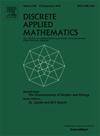Some spectral conditions for star-factors in bipartite graphs
IF 1
3区 数学
Q3 MATHEMATICS, APPLIED
引用次数: 0
Abstract
A spanning subgraph of is called an -factor if every component of is isomorphic to some member of , where is a set of connected graphs. We denote by the adjacency matrix of , and by the distance matrix of . The largest eigenvalue of , denoted by , is called the adjacency spectral radius of . The largest eigenvalue of , denoted by , is called the distance spectral radius of . In this paper, we aim to provide two spectral conditions to ensure the existence of star-factors with given properties. Let be a -edge-connected bipartite graph with bipartition and , where is a sufficiently large positive integer. Then the following two results are true.
(i) If , then contains a star-factor with for any and for any , unless .
(ii) If , then contains a star-factor with for any and for any , unless .
二部图中星因子的一些谱条件
如果生成子图F (G)的每个分量都同构于F中的某个元素,则称为F因子,其中F是一组连通图。我们用A(G)表示G的邻接矩阵,用D(G)表示G的距离矩阵,用ρ(G)表示A(G)的最大特征值称为G的邻接谱半径,用μ(G)表示D(G)的最大特征值称为G的距离谱半径。本文旨在提供两个谱条件来保证具有给定性质的星因子存在。设G为两分(a,B)且|B|=k| a |=kn的k边连通二部图,其中n是一个足够大的正整数。那么以下两个结果是正确的:(i)如果ρ(G)≥ρ(Kn−1,Kn−k−1∇K1,k+1),则G包含一个星因子F,对于任意u∈a dF(u)=k,对于任意v∈B dF(v)=1,除非G=Kn−1,Kn−k−1∇K1,k+1。(ii)如果μ(G)≤μ(Kn−1,Kn−k−1∇K1,k+1),则G包含一个星因子F,对于任意u∈a dF(u)=k,对于任意v∈B dF(v)=1,除非G=Kn−1,Kn−k−1∇K1,k+1。
本文章由计算机程序翻译,如有差异,请以英文原文为准。
求助全文
约1分钟内获得全文
求助全文
来源期刊

Discrete Applied Mathematics
数学-应用数学
CiteScore
2.30
自引率
9.10%
发文量
422
审稿时长
4.5 months
期刊介绍:
The aim of Discrete Applied Mathematics is to bring together research papers in different areas of algorithmic and applicable discrete mathematics as well as applications of combinatorial mathematics to informatics and various areas of science and technology. Contributions presented to the journal can be research papers, short notes, surveys, and possibly research problems. The "Communications" section will be devoted to the fastest possible publication of recent research results that are checked and recommended for publication by a member of the Editorial Board. The journal will also publish a limited number of book announcements as well as proceedings of conferences. These proceedings will be fully refereed and adhere to the normal standards of the journal.
Potential authors are advised to view the journal and the open calls-for-papers of special issues before submitting their manuscripts. Only high-quality, original work that is within the scope of the journal or the targeted special issue will be considered.
 求助内容:
求助内容: 应助结果提醒方式:
应助结果提醒方式:


